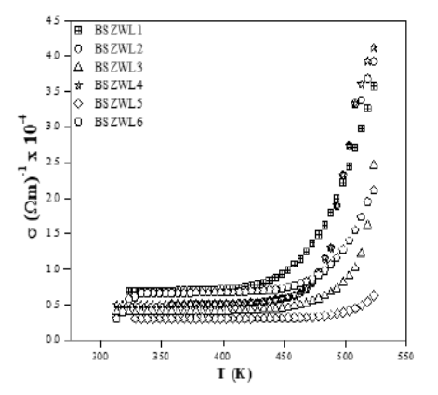


Indian Journal of Science and Technology
Year: 2024, Volume: 17, Issue: 17, Pages: 1767-1775
Original Article
Aravind Dyama1, T Sankarappa1*, Mohansingh Heerasingh1, Ashwini Devidas1, Pallavi Jamadar1, Amarkumar Malge1
1Department of Physics, Gulbarga University, Kalaburagi, 585106, Karnataka, India
*Corresponding Author
Email: [email protected]
Received Date:14 February 2024, Accepted Date:27 March 2024, Published Date:23 April 2024
Objectives: To synthesise a unique set of borosilicate glasses of composition, xLi2O + 0.15SiO2 + 0.45B2O3 + 0.05ZnO + (0.35 – x) WO3; (0.25 ≤ x ≤ 0.34) and to investigate conduction mechanisms. Methods: Glasses were synthesized by melt quenching technique. From the XRD spectra samples were conformed to be non-crystalline in nature. Density has been measured by following Archimedes principle and is found to decrease with Li2O mole fractions in the range 2.900 gm/cm3 – 2.495 gm/cm3. DC-conductivity was measured for the temperature range 303K – 525 K using two probe technique. Findings: It was found that these glasses behave like semiconductors in terms conductivity variation with temperature. Conductivity decreased with Li2O content up to 0.33 mole fractions and increases for higher mole fractions. High temperature conductivity variation i.e., above ϴD/2 (ϴD = Debye’s temperature) is found to follow the Mott’s small polaron hopping (SPH) model. Activation energy for conduction above ϴD/2 is found to be in the range 0.282 eV-0.702 eV. Decrease of conductivity and activation energy with increase of Li2O content has been explained in terms of dynamic nature of network and formation of cation-polaron neutral entities. The conductivity below ϴD/2 has been found to follow Mott’s variable range hopping (VRH) models. The density of states at Fermi level derived from Mott’s VRH are found to be of the order of 1023 eV-1cm-3 which are in close agreement with reported ranges for transition metal oxides doped glasses. Novelty: A unique set of mixed conducting borosilicate glasses have been prepared and investigated thoroughly for conduction mechanisms.
Keywords: Borosilicate glasses, Density, Conductivity, Activation energy, Density of states
© 2024 Dyama et al. This is an open-access article distributed under the terms of the Creative Commons Attribution License, which permits unrestricted use, distribution, and reproduction in any medium, provided the original author and source are credited. Published By Indian Society for Education and Environment (iSee)
Subscribe now for latest articles and news.